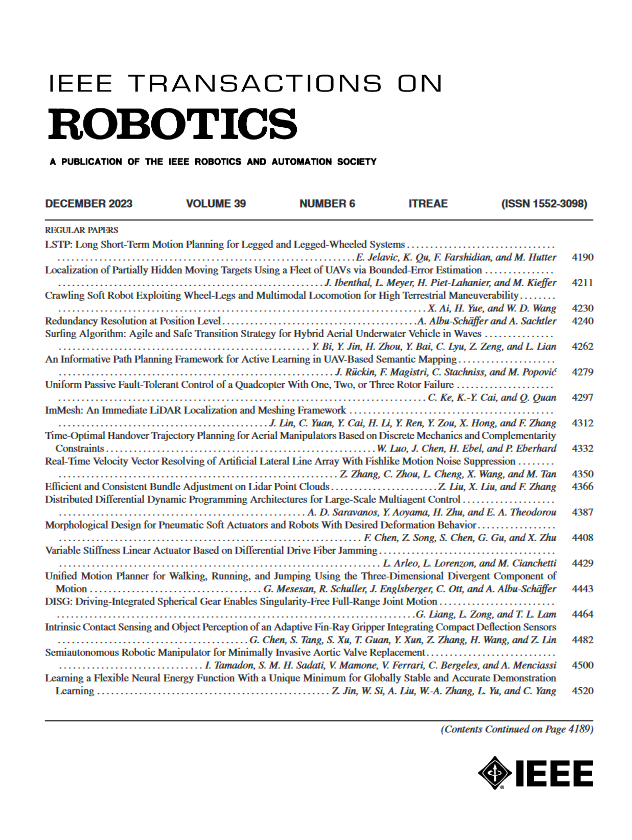Vision-Based Proximity and Tactile Sensing for Robot Arms: Design, Perception, and Control
IF 10.5
1区 计算机科学
Q1 ROBOTICS
引用次数: 0
Abstract
Soft-bodied robots with multimodal sensing capabilities hold promise for versatile and user-friendly robotics. However, seamlessly integrating multiple sensing functionalities into soft artificial skins remains a challenge due to compatibility issues between soft materials and conventional electronics. While vision-based tactile sensing has enabled simple and effective sensor designs for robotic touch, there has been limited exploration of this technique for intrinsic multimodal sensing in large-sized soft robot bodies. To address this gap, this article introduces a novel vision-based soft sensing technique, named ProTac, capable of operating either in tactile or proximity sensing modes. This vision-based sensing technology relies on a soft functional skin that can actively switch its optical properties between opaque and transparent states. Furthermore, this article develops efficient learning pipelines for proximity and tactile perceptions, as well as sensing strategies enabled through the timing activation of the two sensing modes. The effectiveness of the soft sensing technology is demonstrated through a soft ProTac link, which can be integrated into newly constructed or existing commercial robot arms. Results suggest that robots integrated with the ProTac link, along with rigorous control formulation can perform safe and purposeful control actions, which enhances human–robot interaction scenarios and facilitates motion control tasks that are challenging to achieve with conventional rigid links.基于视觉的机械臂接近和触觉传感:设计、感知和控制
具有多模态传感能力的软体机器人有望成为多功能和用户友好的机器人。然而,由于软材料与传统电子产品之间的兼容性问题,将多种传感功能无缝集成到柔软的人造皮肤中仍然是一个挑战。虽然基于视觉的触觉传感使得机器人触觉传感器设计简单有效,但对于大型软机器人本体的多模态感知技术的探索有限。为了解决这一问题,本文介绍了一种新的基于视觉的软传感技术,名为ProTac,能够在触觉或接近传感模式下工作。这种基于视觉的传感技术依赖于一种柔软的功能性皮肤,它可以在不透明和透明状态之间主动切换其光学特性。此外,本文还开发了接近和触觉感知的有效学习管道,以及通过定时激活两种感知模式实现的感知策略。软传感技术的有效性通过软ProTac链路得到验证,该链路可以集成到新建或现有的商用机器人手臂中。结果表明,集成了ProTac连杆的机器人可以执行安全、有目的的控制动作,从而增强了人机交互场景,并简化了传统刚性连杆难以实现的运动控制任务。
本文章由计算机程序翻译,如有差异,请以英文原文为准。
求助全文
约1分钟内获得全文
求助全文
来源期刊

IEEE Transactions on Robotics
工程技术-机器人学
CiteScore
14.90
自引率
5.10%
发文量
259
审稿时长
6.0 months
期刊介绍:
The IEEE Transactions on Robotics (T-RO) is dedicated to publishing fundamental papers covering all facets of robotics, drawing on interdisciplinary approaches from computer science, control systems, electrical engineering, mathematics, mechanical engineering, and beyond. From industrial applications to service and personal assistants, surgical operations to space, underwater, and remote exploration, robots and intelligent machines play pivotal roles across various domains, including entertainment, safety, search and rescue, military applications, agriculture, and intelligent vehicles.
Special emphasis is placed on intelligent machines and systems designed for unstructured environments, where a significant portion of the environment remains unknown and beyond direct sensing or control.
 求助内容:
求助内容: 应助结果提醒方式:
应助结果提醒方式:


